Hyundai Palisade (LX2): Engine Control/Fuel System / Troubleshooting
Basic Troubleshooting Guide
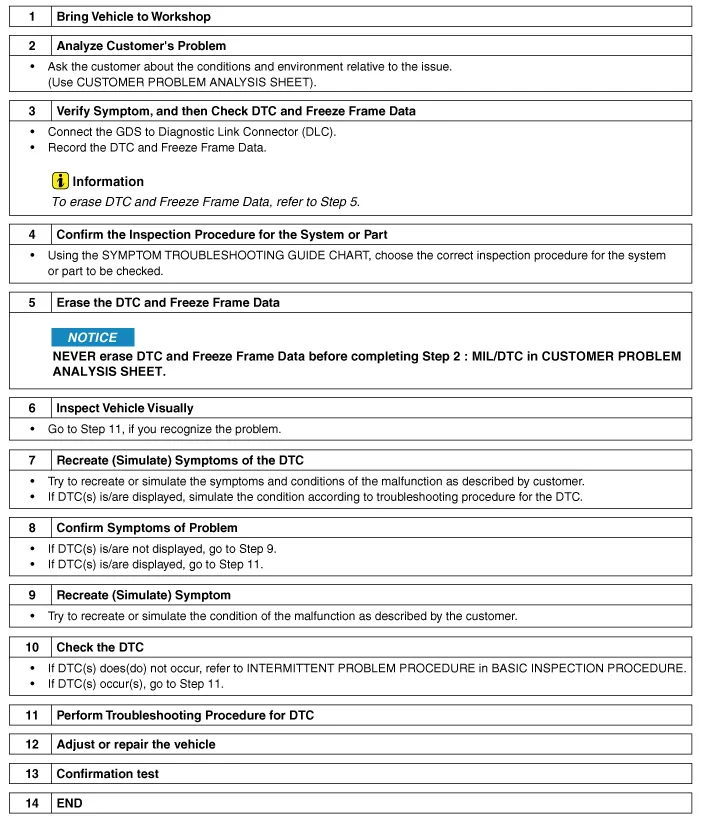
Customer Problem Analysis Sheet
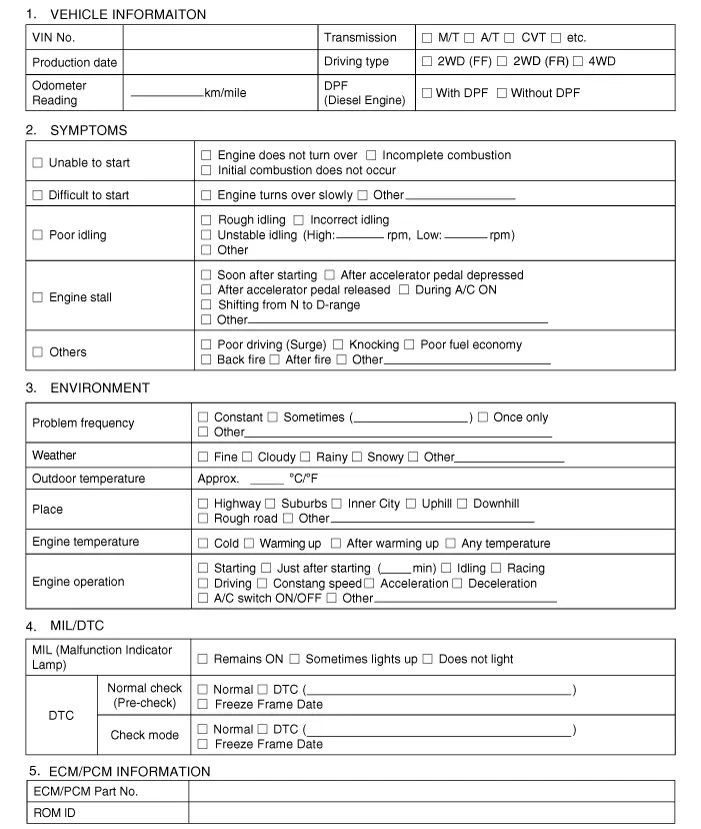
Basic Inspection Procedure
Measuring Condition of Electronic Parts' Resistance
The measured resistance at high temperature after vehicle running may be high
or low. So all resistance must be measured at ambient temperature (20°C, 68°F),
unless stated otherwise.
| • |
The measured resistance except at ambient temperature (20°C,
68°F) is the reference value.
|
|
Intermittent Problem Inspection Procedure
Sometimes the most difficult case in troubleshooting is when a problem symptom
occurs but does not reoccur during test. An example would be if a problem appears
only when the vehicle is cold but has not appeared when warm. In this case,
the technician should thoroughly make out a "Customer Problem Analysis Sheet"
and recreate (simulate) the environment and condition in which the vehicle was
having the issue.
| 1. |
Clear Diagnostic Trouble Code (DTC).
|
| 2. |
Inspect all connections, check terminal for poor connections, loose
wires, bent, broken or corroded pins, and then verify that the connectors
are securely fastened at all times.
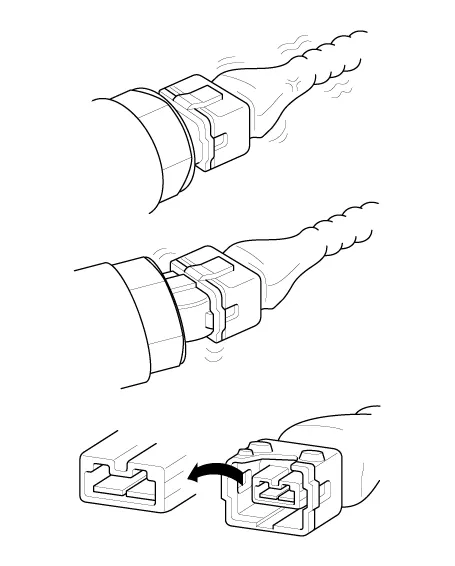
|
| 3. |
Lightly shake the connector and wiring harness vertically and horizontally.
|
| 4. |
Repair or replace the component with a problem.
|
| 5. |
Perform road test to verify that the problem has disappeared.
|
â—Ź Simulating Vibration
| a. |
Sensors and Actuators
: Lightly shake sensors, actuators or relays by finger.
| •
|
Strong vibration may break sensors, actuators or relays.
|
|
|
| b. |
Connectors and Harness
: Lightly shake the connector and wiring harness vertically and then
horizontally.
|
â—Ź Simulating Heat
| a. |
Heat components suspected of causing the malfunction with a hair dryer
or other heat source.
| •
|
DO NOT heat components to the point of damaging them.
|
| •
|
DO NOT heat the ECM directly.
|
|
|
â—Ź Simulating Water Sprinkling
| a. |
Sprinkle water onto vehicle to simulate a rainy day or a high humidity
condition.
| •
|
DO NOT sprinkle water directly onto the engine compartment
or electronic components.
|
|
|
â—Ź Simulating Electrical Load
| a. |
Turn on all electrical systems to simulate excessive electrical loads.
(Radios, fans, lights, rear window defogger, etc.)
|
Connector Inspection Procedure
| 1. |
Handling of Connector
| a. |
Turn on all electrical systems to simulate an excessive electrical
load. (Radios, fans, lights, rear window defogger, etc.)
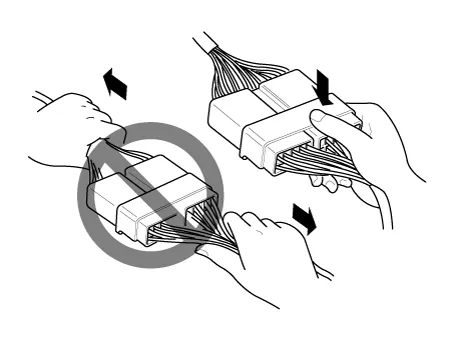
|
| b. |
When removing the connector with a latch, press or pull locking
lever.
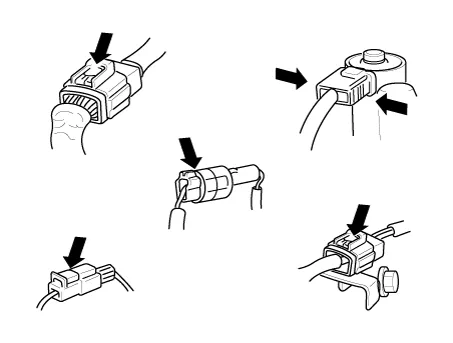
|
| c. |
Listen for a click when locking connectors. This sound indicates
that they are securely locked.
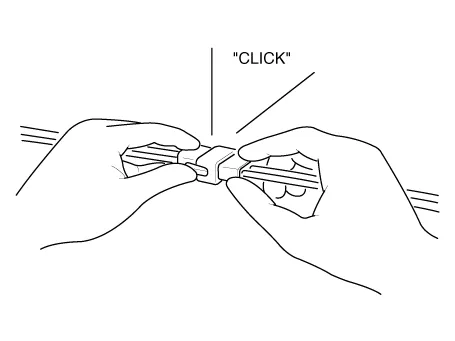
|
| d. |
When a tester is used to check for continuity, or to measure
voltage, always insert tester probe from wire harness side.
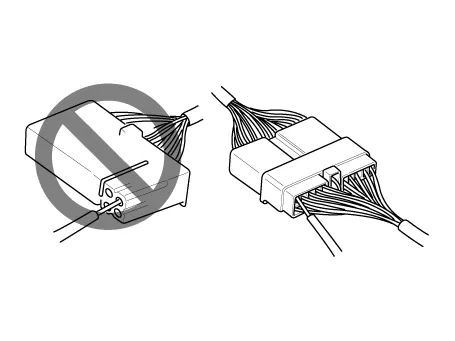
|
| e. |
Check waterproof connector terminals from the connector side.
Waterproof connectors cannot be accessed from harness side.
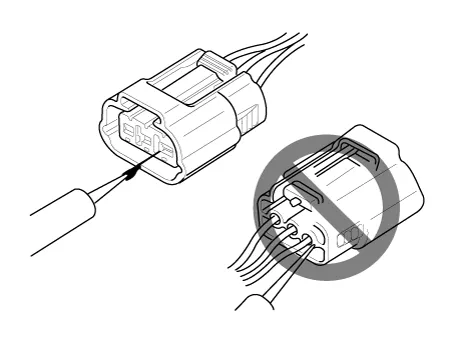
|
• |
Use a fine wire to prevent damaging the terminal.
|
|
• |
Do not damage the terminal when inserting the
tester lead.
|
|
|
|
| 2. |
Checking Point for Connector
| a. |
While the connector is connected :
Hold the connector, and check connecting condition and locking
efficiency.
|
| b. |
When the connector is disconnected :
Check for missing terminal, crimped terminal or broken core
wire by lightly pulling the wire harness.
Visually check for rust, contamination, deformation and bending.
|
| c. |
Check terminal tightening condition :
Insert a spare male terminal into a female terminal, and then
check terminal tightening conditions.
|
| d. |
Pull lightly on individual wires to ensure that each wire is
secured in the terminal.
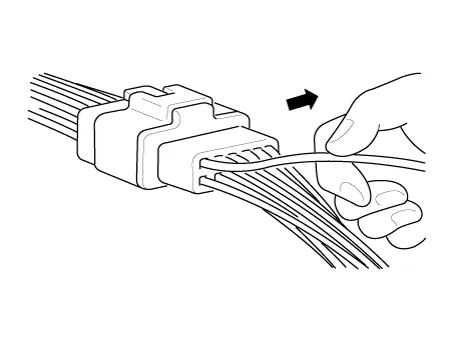
|
|
| 3. |
Connector Terminal Repairing Method
| a. |
Clean the contact points using air gun and/or shop rag.
|
• |
Never use sand paper when polishing the contact
points, otherwise the contact point may be damaged.
|
|
|
| b. |
In case of abnormal contact pressure, replace the female terminal.
|
|
Wire Harness Inspection Procedure
| 1. |
Before removing the wire harness, check the wire harness position and
crimping in order to restore it correctly.
|
| 2. |
Check for twisted, pulled or loose wire harness.
|
| 3. |
Check if the temperature of the wire harness is abnormally high.
|
| 4. |
Check for rotating, moving or vibrating wire harness against the sharp
edge of a part.
|
| 5. |
Check the connection between the wire harness and any installed part.
|
| 6. |
If the covering of wire harness is damaged; secure, repair or replace
the harness.
|
Electrical Circuit Inspection Procedure
â—Ź Open Circuit Test
| 1. |
Procedures for Open Circuit
If an open circuit occurs (as seen in [FIG. 1]), it can be found by
performing Step 2 (Continuity Check Method) or Step 3 (Voltage Check
Method) as shown below.
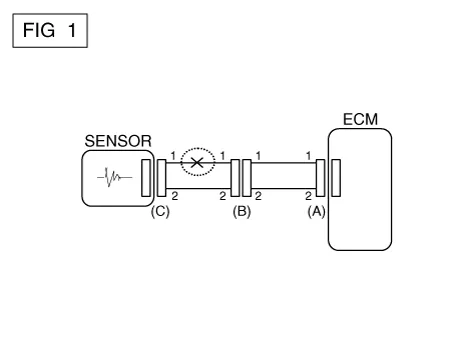
|
| 2. |
Continuity Check Method
| •
|
When measuring the resistance, lightly shake the wire
harness vertically or horizontally.
|
|
|
Specification (Resistance)
1Ω or less → Normal Circuit
1MΩ or Higher → Open Circuit
|
| a. |
Disconnect connectors (A) and (C), and measure resistance between
connectors (A) and (C) as shown in [FIG. 2].
In [FIG. 2], if the measured resistances in lines 1 and 2 are
"over 1MΩ" and "below 1Ω" respectively, line 1 has an open circuit.
(Line 2 is normal.) To find the exact broken point, check the
sub line of line 1 as described in the next step.
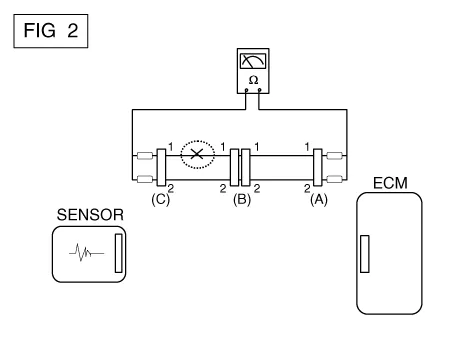
|
| b. |
Disconnect connector (B), and measure the resistances between
connectors (C) and (B1), and between (B2) and (A) as shown in
[FIG. 3].
In this case, the measured resistance between connectors (C)
and (B1) is higher than 1MΩ and the open circuit is between
terminal 1 of connector (C) and terminal 1 of connector (B1).
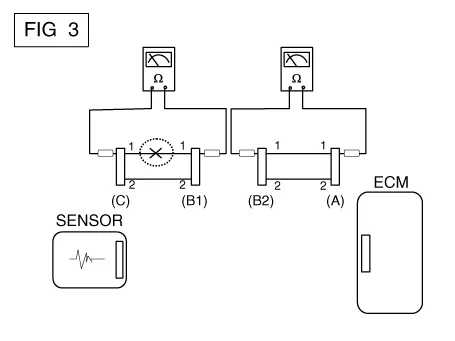
|
|
| 3. |
Voltage Check Method
| a. |
With each connector still connected, measure the voltage between
the chassis ground and terminal 1 of each of connectors (A),
(B) and (C) as shown in [FIG. 4].
The measured voltages of connectors are 5V, 5V and 0V respectively.
So the open circuit is between connectors (C) and (B).
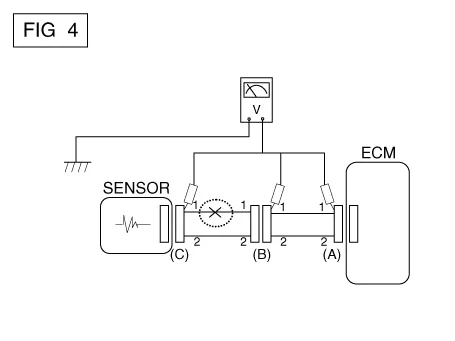
|
|
â—Ź Short Circuit Test
| 1. |
Test Method for Short to Ground Circuit
| • |
Continuity Check with Chassis Ground
|
If short to ground circuit occurs as shown in [FIG. 5], the broken point
can be found by performing Step 2 (Continuity Check Method with Chassis
Ground) as shown below.
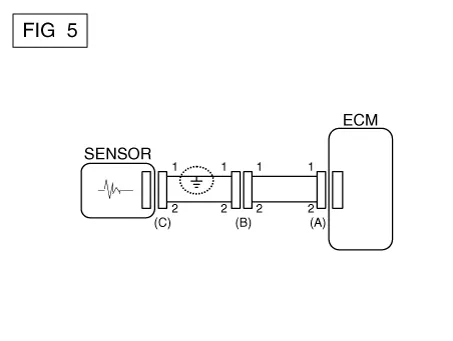
|
| 2. |
Continuity Check Method (with Chassis Ground)
| •
|
Lightly shake the wire harness vertically or horizontally
when measuring the resistance.
|
|
|
Specification (Resistance)
1Ω or less → Short to Ground Circuit
1MΩ or Higher → Normal Circuit
|
| a. |
Disconnect connectors (A) and (C), and measure the resistance
between connector (A) and Chassis Ground as shown in [FIG. 6].
If the measured resistances in lines 1 and 2 are "below 1Ω"
and "over 1MΩ" respectively, line 1 has an open circuit. (Line
2 is normal.) To find the exact broken point, check the sub
line of line 1 as described in the next step.
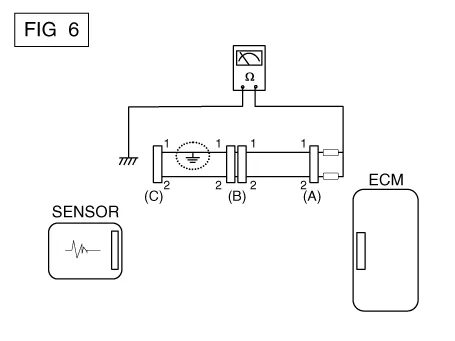
|
| b. |
Disconnect connector (B), and measure the resistances between
connector (A) and chassis ground, and between (B1) and chassis
ground as shown in [FIG. 7].
The measured resistance between connector (B1) and chassis ground
is 1Ω or less. The short to ground circuit is between terminal
1 of connector (C) and terminal 1 of connector (B1).
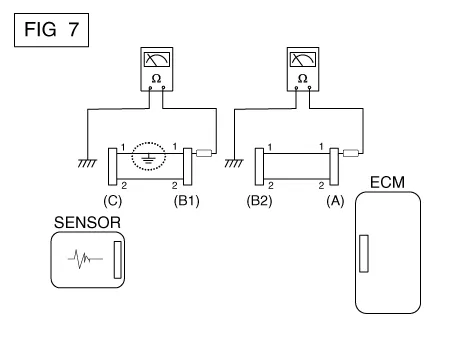
|
|
â—Ź Voltage Drop Test
This test checks for voltage drop along a wire, or through a connection or a
switch.
| A. |
Connect the positive lead of a voltmeter to the end of the wire (or
to the side of the connector or switch) closest to the battery.
|
| B. |
Connect the negative lead to the other end of the wire (or the other
side of the connector or switch).
|
| D. |
The voltmeter will show the difference in voltage between the two points.
A difference, or drop of more than 0.1 volts (50mV in 5V circuits),
may indicate a problem. Check the circuit for loose or dirty connections.
|
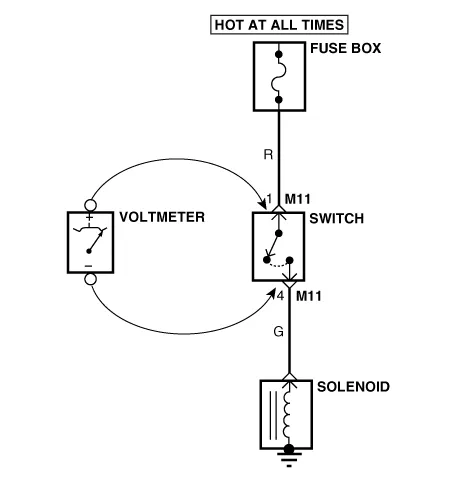
Symptom Troubleshooting Guide Chart
Main symptom
|
Diagnostic procedure
|
Also check for
|
Unable to start
(Engine does not turn over)
|
| 1) |
Test the battery.
(Refer to Engine Electrical System - "Battery")
|
| 2) |
Test the starter.
(Refer to Engine Electrical System - "Starter")
|
| 3) |
Inhibitor switch (A/T) or clutch start switch (M/T)
|
|
|
Unable to start
(Incomplete combustion)
|
| 1) |
Test the battery.
(Refer to Engine Electrical System - "Battery")
|
| 2) |
Check the fuel pressure
(Refer to Fuel Delivery System - "Fuel Pressure Test")
|
| 3) |
Check the ignition circuit.
(Refer to Engine Electrical System - "Ignition System")
|
| 4) |
Troubleshoot the immobilizer system.
(Refer to Body Electrical System - "Immobilizer System")
(In case of immobilizer lamp flashing)
|
|
| • |
Slipped or broken timing belt
|
|
Difficult to start
|
| 1) |
Test the battery.
(Refer to Engine Electrical System - "Battery")
|
| 2) |
Check the fuel pressure
(Refer to Fuel Delivery System - "Fuel Pressure Test")
|
| 3) |
Check the ECT sensor and circuit (Check DTC)
|
| 4) |
Check the ignition circuit.
(Refer to Engine Electrical System - "Ignition System")
|
|
|
Poor idling
(Rough, unstable or incorrect idle)
|
| 1) |
Check the fuel pressure.
(Refer to Fuel Delivery System - "Fuel Pressure Test")
|
| 2) |
Check the injector.
(Refer to Engine Control System - "Injector")
|
| 3) |
Check the long term fuel trim and short term fuel trim.
(Refer to CUSTOMER DATASTREAM)
|
| 4) |
Check the idle speed control circuit. (Check DTC.)
|
| 5) |
Inspect and test the Throttle Body.
|
| 6) |
Check the ECT sensor and circuit. (Check DTC.)
|
|
|
Engine stalling
|
| 1) |
Test the battery.
(Refer to Engine Electrical System - "Battery")
|
| 2) |
Check the fuel pressure.
(Refer to Fuel Delivery System - "Fuel Pressure Test")
|
| 3) |
Check the idle speed control circuit. (Check DTC.)
|
| 4) |
Check the ignition circuit.
(Refer to Engine Electrical System - "Ignition System")
|
| 5) |
Check the CKPS circuit. (Check DTC.)
|
|
|
Poor driving
(Surge)
|
| 1) |
Check the fuel pressure.
(Refer to Fuel Delivery System - "Fuel Pressure Test")
|
| 2) |
Inspect and test Throttle Body.
|
| 3) |
Check the ignition circuit.
(Refer to Engine Electrical System - "Ignition System")
|
| 4) |
Check the ECT sensor and circuit. (Check DTC.)
|
| 5) |
Test the exhaust system for a possible restriction.
(Refer to Engine Mechanical System - "Exhaust Manifold")
|
| 6) |
Check the long term fuel trim and short term fuel trim.
(Refer toCUSTOMER DATASTREAM.)
|
|
|
Knocking
|
| 1) |
Check the fuel pressure.
(Refer to Fuel Delivery System - "Fuel Pressure Test")
|
| 2) |
Inspect the engine coolant.
(Refer to Engine Mechanical System - "Radiator")
|
| 3) |
Inspect the radiator and the electric cooling fan.
(Refer to Engine Mechanical System - "Radiator")
|
| 4) |
Check the spark plugs.
(Refer to Engine Electrical System - "Ignition System")
|
|
|
Poor fuel economy
|
| 1) |
Check customer's driving habits.
· Is the A/C or the defroster mode on full time?
· Are tires at correct pressure?
· Is excessively heavy load being carried?
· Is acceleration too much, too often?
|
| 2) |
Check the fuel pressure.
(Refer to Fuel Delivery System - "Fuel Pressure Test")
|
| 3) |
Check the injector.
(Refer to Engine Control System - "Injector")
|
| 4) |
Test the exhaust system for a possible restriction.
|
| 5) |
Check the ECT sensor and circuit.
|
|
|
Hard to refuel
(Overflow during refueling)
|
| 1) |
Inspect the fuel filler hose/pipe.
· Pinched, kinked or blocked?
· Filler hose is torn
|
| 2) |
Inspect the fuel tank vapor vent hose between the EVAP. canister
and air filter.
|
| 3) |
Check the EVAP. canister.
|
|
| • |
Malfunctioning gas station filling nozzle (If this problem occurs
at a specific gas station during refueling)
|
|
Special Service Tools
Tool Name / Number
Illustration
Description
Fuel Pressure Gauge
09353-24100
Used for measuring the pressure in fuel line
Fuel Pressure Gauge Adapter
0K353-D4100
Used for connecting between high pressure fuel pump and low pressure fuel
feed tube to measure the pressure in fuel line
※SST 09353-C1000 also can be used
Heated Oxygen Sensor Socket Wrench
09392-1Y100 (19 mm)
Removal and installation of the heated oxygen sensor
※ SST No.
Other information:
Specification
Air Conditioner
Item
Specification
Compressor
Type
7VSX18 (External Variable Displacement Swash Plate)
Oil type & Capacity
PAG 180 ± 10cc (6.
Components and components location
Component
Connector Pin Function
Connector
PIN No
Pin Function
Connector
PIN No
Pin Function
A
1
Battery
A
21
IGN2
2

























